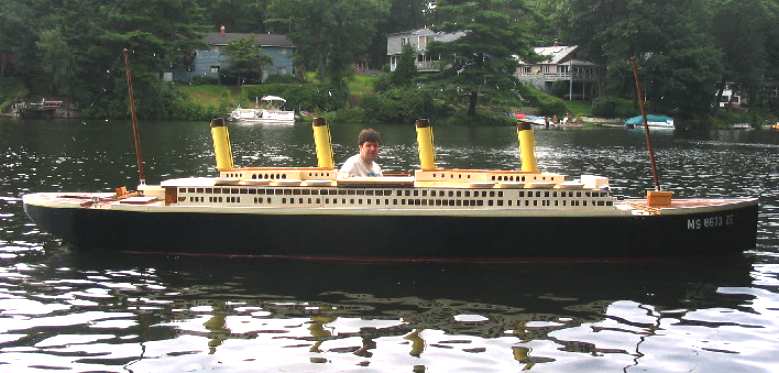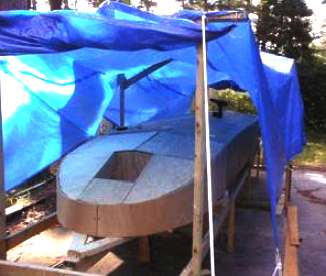

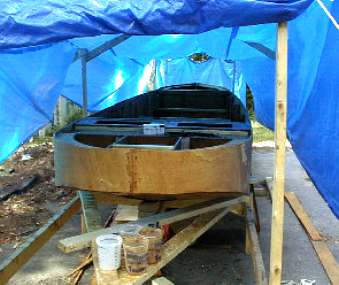
It's
not the result, it is also how we got there that is so interesting. Clearly,
Kevin improved his facilities as the project progressed, from this makeshift
tarpaulin with pole supports, to the much more spacious framed unit below.
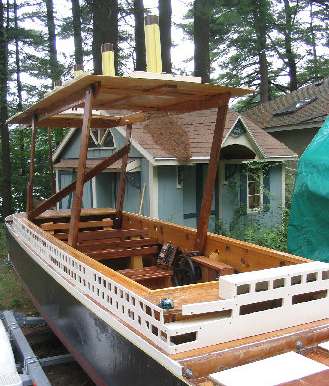
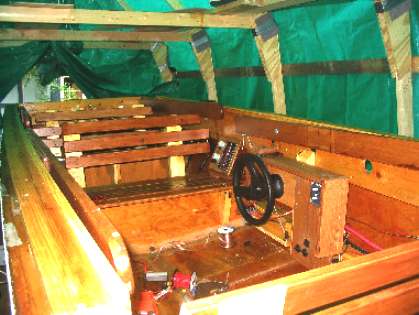
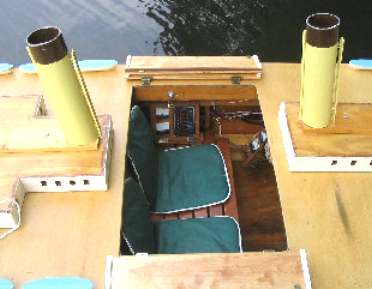
We
like the hinged deck to allow the skipper entry - and note the side mounted
rudder controls
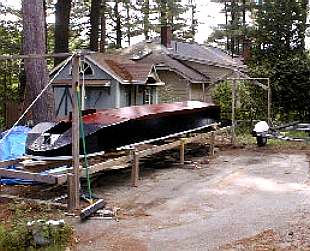
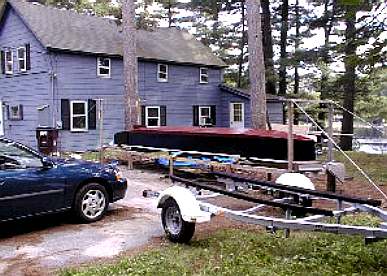
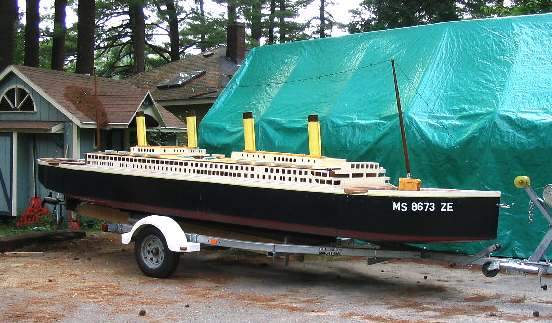
The
location for this kind of project is perfect. Lake Boon is clearly visible just
a hop, skip and jump away.
The two 70 watt solar panels used
to charge the Solar Titanic, along with a controller and wiring
cost about $700. This will support about 2/3 of a horse power
for 10 hours a week during the long days of summer. Kevin
installed the panels on my dock, but says that people expecting
a couple of solar panels and 4 storage batteries to be a
replacement for a 200 horse power outboard motor will be greatly
disappointed.
Electric powered boats based on
lead-acid storage batteries are viable as long as you don't need
to go very fast or very far (water skiing will have to wait
until fuel cells finally become viable). But if you are looking
for quiet, casual cruising then electric powered boats make a
lot of sense.
So now lets look at the whether or not solar panels make sense
for a small electric boat. The previous pages established a bit
of background on how I view alternate energy questions in
general. The same basic rules apply to pretty much all alternate
energy projects:
You have to be hard-nosed
and realistic about:
1) how much energy is really available
2) evaluating your energy requirements
3) understanding how well the two match up.
Kevin says: "I found my
solar panel by cruising the web. The going rate for new PV
(Photo-Voltaic) panels seems to be a bit under $4 a watt. I
wound up buying a 70 watt panel for $269.00. This can produce a
maximum of 70 watts if full, unobstructed sunlight is shining at
a right angle onto the panel."
Note:
1) How much energy is available?
-
if the sun is more than
about 30 degrees from a right angle the output falls off
fast.
-
if it is an overcast day,
the PV panel will only produce about 30% of rated output.
-
a "12 volt" panel
is typically 36 solar cells in series to produce the 17 or
18 volts needed to charge a 12 volt battery. Even slight
shading from a cable stay (for example) on a few of the
cells will significantly reduce output.
2) What are the energy
requirements?
The latest edition of the
Solartanic uses two 24 volt, 54 pound thrust Minnkota trolling
motors.
-
At full power the motors
draw about 45 amps@ 24 volts = 1080 watts while pushing the
boat just under 5 MPH.
-
Cruising speed is defined
(rather arbitrarily) at 20 amps@24 volts or 480 watts which
pushes the boat just under 4 MPH.
-
Note that 1 HP = 746
watts
so full power works out to about 1.5 HP, although in
practice the motors are not 100% efficient.
-
Kevin currently has four 12
volt marine duty batteries (arranged in 2 pairs to produce
24 volts) with a realistic capacity of 100 amp hours. So I
can get a bit over 2 hours at full speed
or 4 to 5 hours at normal cruising speed out of a charge.
The boat still moves along nicely at 10
amps in which case the batteries last about 10 hours. The
boat could easily hold two or three
times as many batteries if needed, but Lake Boon is not very
big so the current battery capacity
seems adequate.
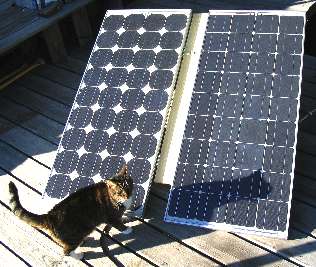
And
finally "kitty" (Frisky) gets to investigate solar power - which she
says is not as interesting as tuna
or go-cat.
3) How well do power
requirements and availability match?
Directly powering the motors from
solar panels is an expensive and inconvenient proposition:
-
Full power would require at
least fifteen 70 watt panels (at close to $4000) and then
only under the most favorable conditions.
-
Even cruising speed would
require 7 panels, again under ideal conditions.
-
If we wish to maintain
cruising speed when it is cloudy, we need three times as
many panels. Even then, what do you do when the sun goes
down? Or when shaded by trees on a small lake
or river?
-
Mounting 7 panels that are
roughly 2x4 feet (let alone 15 or 21 panels) on a 22 foot
boat is a bit of a problem (particularly if your trying to
maintain the profile of the Titanic!)
After initial investigation, Kevin
quickly disregarded the idea of mounting the panels to the boat.
It just didn't seem practical: it was too expensive and
certainly didn't fit the "look" he was after. There
are boats on the web that do run directly from solar
panels, but they tend to have large flat surfaces for mounting
them. Catamarans are often popular for this type of boat since
they provide a lot of square footage and can provide a somewhat
higher cruising speed at low power.
The obvious alternative is to run on batteries and mount the
solar panels to the dock instead of the boat. It is (usually)
much easier to orient the panels to maximize the energy
collected. Since Kevin lives right on Lake Boon, his boat, like
many pleasure boats, will spend most of its time at the dock
where the panels can charge the batteries. Kevin estimates on
how he typically uses his boat:
He picked 10 hours a week as an
average utilization.
Two 70 watt panels (in series
to provide 24 volts) can provide a maximum of 140 watts. Making
some allowance for less than perfect efficiency, it takes 4 or 5
hours of good sunshine for each hour of cruising at 480 watts,
or between 40 and 50 hours a week. Given the long days of
summer, an average week should provide enough sunshine to
support 10 hours of cruising. Kevin's experience at the end of
last summer (with the Solartanic's original 12 volt motor and
single solar panel) seemed to confirm this estimate. He recently
received his 2nd solar panel and will be observing the new setup
as soon as he gets it installed.
Is it worth doing this? The panels
cost about $540 and will be generating about 50 cents of
electricity per week. However it would cost several hundred
dollars to have an electrician install a GFI protected line down
to the dock so, Kevin decided the solar panels were worth it. So
the short story is:
-
$700 worth of solar panels,
controller, wiring etc will support 2/3 of a HP for about 10
hours week. If this meets your requirements, it may be cost
effective if you don't already have 120 volt power at your
dock.
-
As with most forms of
alternate energy, you must be willing to live with the
statistical averages unless you have a backup power source.
-
The Solartanic will most
likely only exceed the averages if I trailer it away from
Lake Boon to show it off. If the boat is in my drive way on
the trailer its easy to hitch up the battery
charger and charge the batteries using house power.
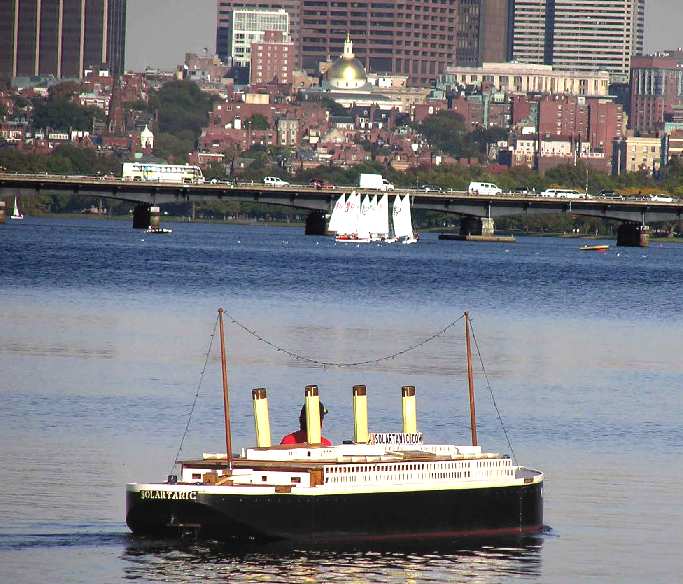
COMMENT
Firstly,
we share Kevin's interest in the Titanic and he should note that the Australian
Entrepreneur, Clive Palmer, is planning to build the Titanic II - so we are not
alone. This was a truly epic project that took over the lives and living room,
of Kevin and his (extremely tolerant) wife. The results are well worth the
effort, and yes we agree with Kevin that a production version should have a more
efficient hull. You may find takers in an environmental theme park. Technology
is advancing to the stage where solar ships may well ply the oceans one day
soon. it all depends on political will.
CONTACTS
Kevin
lives in an idyllic location for boat lovers as you can see from
his photographs - lucky man. Kevin says that he is interested in almost all forms of
alternative energy and almost any boating topic. If you have comments
on his project you can
e-mail him directly at: kevin@solartitanic.com
Kevin Cassidy
10 Davis Rd
Stow, Ma 01775
Links to suppliers:
http://www.windsun.com/
http://www.altenergystore.com/
http://www.systemthree.com/
http://www.boatdesigns.com/
Electric Boat Links:
Electric
Boat Association of the Americas
Electric
Boating
Don
Robertson's Marine Marketplace
Boat
Owner's electric boating links
Electric
Boats and Outboards
Titanic Links:
titanic-titanic.com
Titanic
Research and Modeling Association
Encyclopedia
Titanica
Titanic
in 30 seconds, re-enacted by bunnies (very funny)
LINKS
http://www.solartanic.com/
Solar
Titanic
